El Cortez, first luxury hotel-casino in downtown Las Vegas, turns 80
Original owners used Mexican resort as architectural inspiration
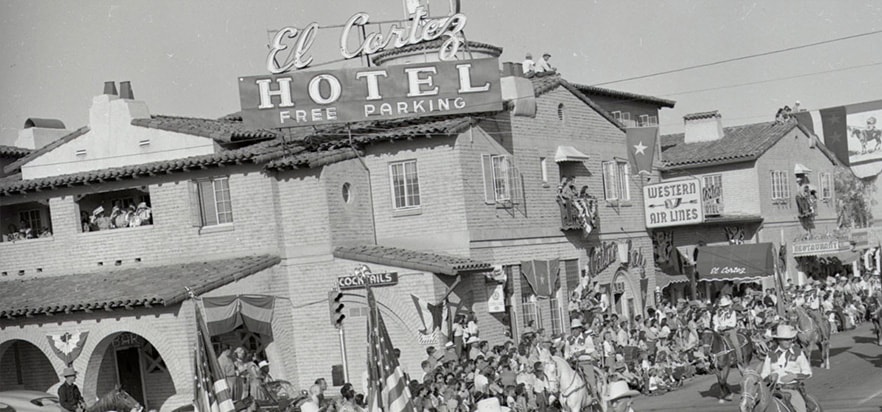
In the late summer of 1939, John C. Grayson, casino manager of the Mt. Baker illegal gambling ship, was arrested with nine other crew members off the coast of Long Beach, California. The state’s attorney general, Earl Warren, ordered all four floating casinos, lurking three miles out in the Pacific Ocean, closed down for good.
Released from jail, Grayson moved back to Phoenix, where he once ran several illicit gambling houses and later a horse race betting business with Chicago Outfit-connected bookmaker Gus Greenbaum. But, according to Grayson, East Coast racketeer Benjamin “Bugsy” Siegel cut off Grayson’s access to the wire service transmitting race results.
Grayson, out of business, was at a loss – a casino expert living in Phoenix where gambling was unlawful, Mob-controlled and required juice and political payoffs to operate. But then an opportunity came his way. In December 1939, Marion Hicks, one of Grayson’s partners (including Bennie Benson and George Perry) in the defunct Mt. Baker, turned up from Southern California.
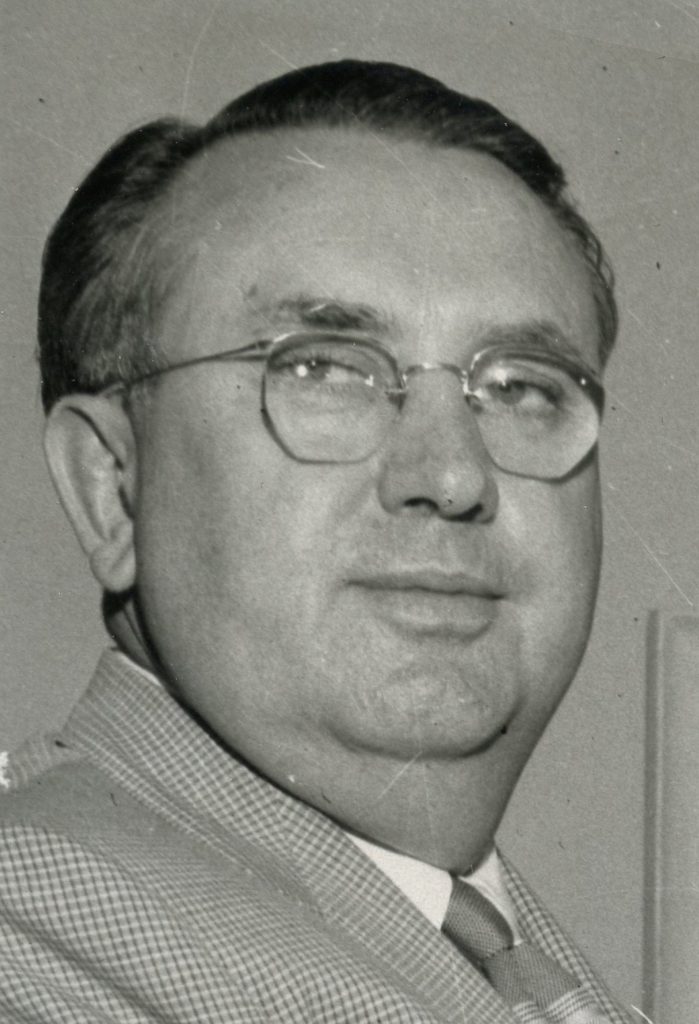
“Marion Hicks drove in, in Phoenix, asked me if I had $75,000 in cash, and I told him I could get it,” Grayson recalled in a 1983 oral history for the University of Nevada, Las Vegas. “He asked me to meet him in Las Vegas tomorrow at noon.”
Nevada had legalized casino gambling in 1931, but the industry was slow to develop in Las Vegas. Hicks, from Los Angeles, wanted to use Grayson’s investment to buy the Frontier Club on Fremont Street, offered by owner Guy McAfee. Grayson jumped at the chance.
“I got up the next morning, drove to Las Vegas and we met Mr. McAfee,” he said. “There was no business in Las Vegas – they had no money, no business.”
Yet when McAfee raised his price to $80,000 and then $85,000, Hicks looked for another opportunity.
“The next day, Hicks met with the city commission in Las Vegas, and they were so desperate for hotels that they agreed to give a gambling license and a liquor license if we would build a 60-room hotel down in that lot where the El Cortez is today. We put up a thousand dollars, I put up a thousand dollars, for an auction, $15,000 for that block . . . the entire block.”
The two men, part of a group of ex-pat Southern California casino pros ousted during anti-gambling crackdowns in the late 1930s, were on their way to create the El Cortez hotel-casino, which celebrates its 80th birthday on November 7.
The El Cortez, opened in 1941 at Sixth and Fremont streets, would become an important milestone in the development of Las Vegas, the first luxury (such as that was then) hotel to grace downtown, and at an auspicious time.
“Here’s a brand new hotel, the only really modern hotel in town,” Grayson recalled. “Everything else had been here for 30 years or more, you know. But the only thing that [came] close to it was the Apache . . . an old hotel” several blocks west on Fremont Street.
By the end of 1938, Las Vegas had hit a slow patch, as the “dam boom” of tourism from the 1935 debut of Hoover Dam faded. Many visitors made only brief trips to check out the dam, 25 miles south of Las Vegas. The populace of greater Las Vegas stood at fewer than 10,000 people, far smaller than the Southern California gambling market that Grayson and Hicks once exploited.
Ria Gable boosts Las Vegas
However, in January 1939, Las Vegas benefited from an unexpected infusion of national publicity, and a resultant building surge. After Nevada in 1931 approved a law requiring only six weeks of residency to file for divorce, most would-be divorcees flocked north to the more well-established city of Reno to kill the time to become a legal Nevadan. Judges typically granted divorces at hearings taking only minutes to complete. Reno achieved fame coast-to-coast as the state’s divorce capital.
But that distinction was about to change. Maria “Ria” Gable, estranged wife of Hollywood matinee idol Clark Gable, opted to end her marriage in Las Vegas instead – citing its “nice” people – and began her 42-day wait to file. At the time, Clark was dating movie actress Carole Lombard and acting in Gone with the Wind.
McAfee, the former Los Angeles police vice commander who quit the force to make money running illegal casinos, had already relocated to Las Vegas to start anew as a legal gamer. Following the September 1938 recall of corrupt L.A. Mayor Frank Shaw, new “reform” Mayor Fletcher Bowron declared war on vice rackets and crooked cops, closing the city’s illicit casinos, including McAfee’s Clover Club on the Sunset Strip.
Others experienced in the once-flourishing L.A. illegal gambling profession and the banned gambling vessels, such as the Mt. Baker, also took off to Las Vegas to look for jobs. Those included L.B. “Tutor” Scherer, Farmer Page and, a bit later, Tony Cornero, owner of the closed casino ship, the S.S. Rex.
“Everybody that came to Las Vegas came from the boat – the waitresses, the shills, the dealers, the cooks, all of them,” Grayson said. “That’s all there was. There was no place to go.”
Meanwhile, McAfee moved to capitalize on the enormous publicity Ria Gable’s scheduled divorce generated for Las Vegas. Ria quietly entered Las Vegas – via an arduous car drive from Los Angeles – the night of January 20, 1939. News about her intended legal action hit the front page of the Las Vegas Evening Review-Journal the next day. Her residence complete as of March 3, she would file for divorce March 4.
McAfee accelerated plans to open two Las Vegas casinos. He acquired a two-story building at 113 Fremont Street downtown that housed a Cornet Five and Dime store and a skating rink. There he would build the Frontier Club, what a Los Angeles newspaper described as a “high-class sawdust” place. Second, he would revamp the old Pair-O-Dice casino on Los Angeles Highway (aka Highway 91, later Las Vegas Boulevard) for his new gaming establishment, the 91 Club, set to open on February 15. The 91 Club would have table games, a café, nightclub, bungalows and an airstrip, all of interest, he hoped, to fashionable Southern Californians.
On January 23, McAfee sent his associate, Fred Krieger, to request gaming permits from the Las Vegas city commission for the two casinos. Not only did the commission members grant McAfee licenses for roulette, craps and other games, in their zeal to foster more development, they voted unanimously to rescind the city’s set limit of five gaming licenses and 16 tavern permits.
“Neither the taverns nor the gambling operators appear to want the limitations,” Mayor H.P. Marble stated.
Word about McAfee’s projects, and the increase in available gaming and liquor licenses, persuaded owners of the city’s top casinos on Fremont Street – the Boulder, Apache, Northern and Las Vegas clubs — to announce improvements and expansions. At the time, the city had only four hotels and 18 bars.
The opportunity to cash in on Ria Gable wasn’t lost on other local businesses. The Las Vegas Chamber of Commerce launched a drive to publicize the town and raised raised $6,000 (about $111,000 today) from donations ranging from $5 to $300.
That winter, after McAfee tried to sandbag Grayson and Hicks on the Frontier, the partners walked into the better deal for the future site of the El Cortez. Working with the city, Grayson put up another $1,500 to buy the vacant city block behind the site.
Ensenada inspiration
Grayson returned to Phoenix to pack. Before returning to Las Vegas, he and Hicks took a quick detour, to Ensenada, 70 miles south of the border on the west coast of Baja California. They intended to design their El Cortez project based on a beachside resort there, the Playa Ensenada Hotel (aka Playa del Ensenada, or Playa de Ensenada), built by boxing legend Jack Dempsey and partners in 1930. They obtained the resort’s construction plans.
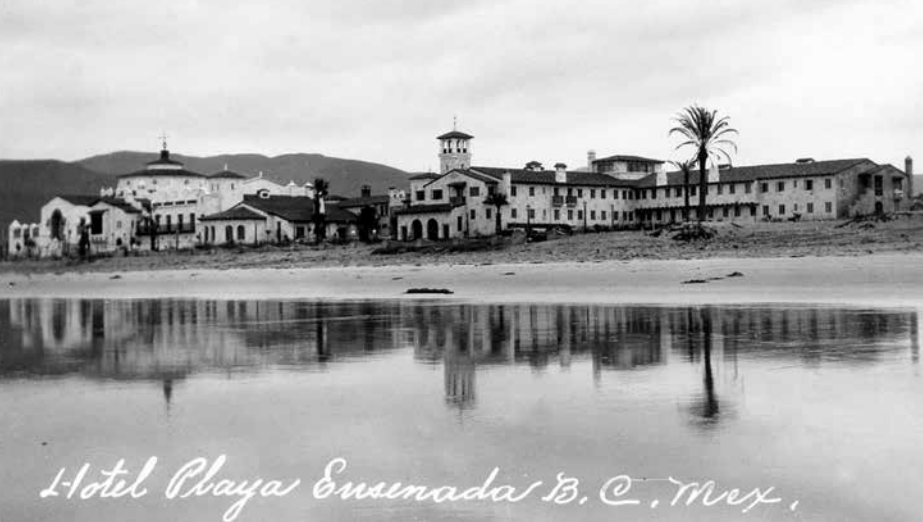
“We liked that old hotel down there,” Grayson remembered. “It’s an old Spanish-style hotel. I went, started in, I got a crew of four men and made 240,000 concrete blocks. Marion took the architect, started drawing up the plans.”
The architect was Raymond Abos of Beverly Hills. “Reason we got him,” Grayson said, “is because he worked cheap. He was one of the young Mexican architects. He drew up the plans, and I had the blocks made, and we started the hotel.”
Next, they hired local general contractor C.W. Jorgensen to install wiring and plumbing into the ground to show “intent” to construct a building, the first step to qualify for a loan from First National Bank. Grayson explained that, for some reason, they bypassed the bank’s Las Vegas manager Cyril Wengert and got the loan from the Reno branch, an early example of a Nevada bank financing a casino.
“And we made [received] a very substantial loan because they wanted to get into the gambling business,” he said. “And Marion showed that I had been a successful operator and arranged a good loan. Then we started to build the building.”
For the construction team, Grayson said that while Las Vegas “was a strong union town,” the El Cortez partners resisted hiring union carpenters who hailed “from Long Beach that didn’t know how to do anything and wouldn’t work.”
Instead, they heeded advice from “the old man,” town pioneer and lumber magnate Ed Von Tobel Sr., to “go to Cedar City, get those Cedar City Mormons. He said, ‘They’ll build this hotel for you.’ And he sold us the material. So we contacted the Cedar City Mormons. . . . [T]hey came down here. They wouldn’t join the union, we paid their dues, they never went to a meeting. . . . We paid union wages.”
Grayson related how Hicks basically appropriated interior design ideas for the El Cortez from a professional based in Los Angeles. “Oh, Hicks was pretty good. We hired a decorator, he came here, Hicks got him drunk, talked to him all night, fired him . . . and then Hicks decorated.”
Los Angeles turned out to be their salvation for ordering plumbing, carpeting and other materials required during construction, and for two or three years after completing the El Cortez.
“This [Las Vegas] was a – you couldn’t buy anything,” Grayson said. “You couldn’t buy a ham sandwich here. There was nothing here but poker games. . . . This was a pretty small town —wasn’t any people here. I think there was two doctors here.”
Still, for veteran casino operators Grayson and Hicks, Las Vegas, for all its faults, was the “only place there was. It wasn’t a good place — there was no more.”
Also, while in town, both men recognized some of their old gambling customers. “And we saw a lot of the players from the boat [Mt. Baker] walking up and down the street, looking in the windows.”
Grayson claimed, after the El Cortez’s grand opening on November 7, 1941, that 15 to 20 percent of their early patrons used to gamble at the Mt. Baker.
El Cortez opens
After about eight months of construction, the $325,000 (also reported as $350,000) El Cortez debuted to hundreds of guests. MGM studios bandleader Jack Martin and his five-piece ensemble, with vocalist Margaret Lewis, provided the entertainment. A 125-seat dining room run by Phoenix restaurateurs Max and Janet Van der Bilt served special dinners at $2.50 a head.
The not-yet-completed three-floor hotel – air conditioned throughout, unusual and very expensive in those days – had a reported 91 “sound-proofed” guest rooms, including eight luxury suites, a casino open from 11 a.m. to 3 a.m. the next day, a beauty parlor, cocktail lounge with dance floor, outdoor porch and patio and a staff of 125 employees. Management cited the hotel’s Western-style décor as providing a “last frontier” atmosphere.
As recounted in the Review-Journal on November 8: “The off-white walls of the lounge are accentuated by the colorful carpet of light maroon. . . . The bar is very modern in design, having a series of connected mirrors as the back bar, with wide carved mirrors at the extreme ends. The latter show artistic cowboy action scenes which will be lighted indirectly. . . . All [guest room] baths are tiled and plumbing fixtures are in color, harmonizing with the color scheme of the bedroom. All baths have both showers and tubs and some of the rooms have stall showers. . . . The powder room off the lounge is the most elaborate in the city of Las Vegas.”
World War II started only weeks later, and wartime restrictions made Freon for the resort’s air conditioning hard to get. Grayson said they had to “bootleg” the refrigerant gas on the sly. Then Nevada’s well-connected Democratic senator, Pat McCarran, pulled strings to deliver them the Freon. McCarran located his Las Vegas political office at the El Cortez for several years.
“He didn’t think he was going to stay in a room that wasn’t conditioned,” said Grayson, who served as president of the hotel and casino.
Grayson later hired back the band and female dancers who performed at the Mt. Baker.
In the early 1940s, the hotel had no formal security, just Grayson and his casino floor employees.
“Those days, you had no protection — you had no police protection,” he said.
“Everyone that came along wanted to either borrow something, get drunk, kick a table over, steal something, or cheat you out of something. . . . But you had to stop it. Of course, I had help. I had dealers that would help me, but that’s the way it was.”
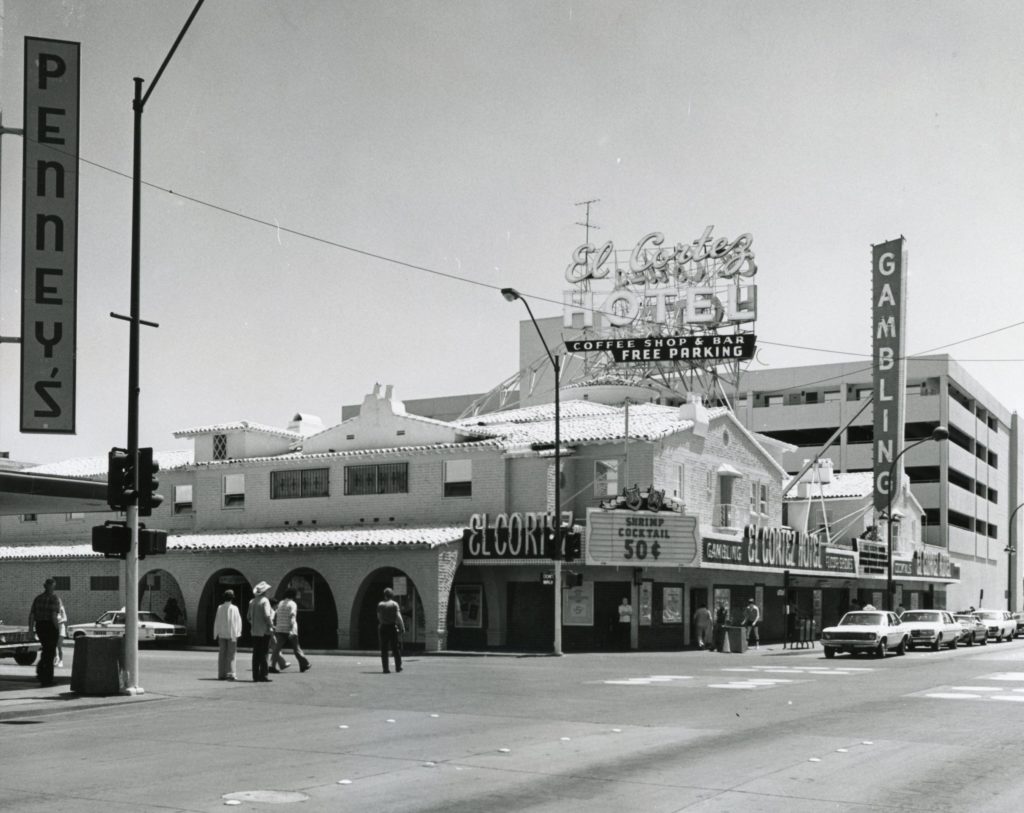
However, Las Vegas had only one highway out of town, a fact that Grayson said discouraged robberies. “No way to get out of here much — [we] had no problems that way. If somebody was caught cheating, you just went over and told him, shook your head at him, nodded at the door, and he was smart enough to know that he was caught and he’d walk on out.”
And since most of his dealers worked for him at the Mt. Baker and knew him well, they were honest and worked “open tables,” meaning he trusted them to deliver the cash their gambling games collected.
“We had very little problem with money, and very little check on their [dealers] money. . . . Somebody cashed in a couple, three hundred dollars [in chips], you just pull out the drawer and hand them the money, and that was all there was to it. . . . We had no box men . . . I had to take care of all those things. If there was a big cash-in, I’d take it to the office, or if a man wanted to cash a check, I’d have to go over and okay his credit. It was a different operation.”
Enter the Mob
By 1945, Grayson started to grow weary of working 16-hour days on his feet. In March, he and Hicks decided to sell the El Cortez. In the oral history, he identified the buyers as “Gus Greenbaum and Bugsy Siegel,” although the names of the infamous gangsters did not appear in newspapers at the time.
The Review-Journal mentioned the purchasers as Edward Berman (a racketeer and surely fronting for his cousin, Minneapolis gangster Davie Berman) and Moe Sedway (Siegel’s close associate). The sale price was reported as $800,000 (about $12 million today), a tidy profit for Grayson and Hicks.
However, the purchase figures for the El Cortez in 1945 and the subsequent sale in 1946 are in dispute. Part of the reason is that both deals involved Sedway and other organized criminals seeking to hide their assets and famous for avoiding or evading federal taxes.
From news reports, in a reorganization in December 1945, Edward Berman left the El Cortez as an investor and Greenbaum officially was in (mentioned in the Review-Journal), with Sedway, who not surprisingly refused to name others in their investment syndicate to reporters.
Then in July 1946, the Sedway-Greenbaum group sold out to local casino owner J. Kell Houssels and his partner Raymond Salmon, neither of whom had Mob ties. The reported sale price was $629,314.44, which, if the $800,000 sale price was accurate, would amount to a loss for the mobsters of about $170,000, which is not believable.
Subsequent research of records of the Internal Revenue Service, according to some historians, indicate that hidden stakeholders, including Siegel and Meyer Lansky, actually made a profit of about $160,000 on the 1946 sale.
The criminal conspiracy of Sedway, Greenbaum, Siegel, Lansky, et al then turned to their clandestine investments in the Flamingo Hotel project on the L.A. highway. The El Cortez amounted to a springboard for behind-the-scenes organized crime infiltration in Las Vegas casinos that continued, to a declining degree, into the 1980s.
After selling the El Cortez, Grayson and Hicks moved to Reno and started the Frontier Club there, but they didn’t like the city and soon left. Both reentered the casino game in Las Vegas. Hicks would join Houssels as partner in the El Cortez a few years later, and then he spearheaded the development (with Lansky as a silent partner) of the Thunderbird Hotel on the Las Vegas Strip in 1948. Grayson retired to Arizona until the mid-1950s, when he returned to assist casino mogul Major Riddle for a while as casino manager of the then-troubled Dunes Hotel. Hicks died in 1961 and Grayson in 1987.
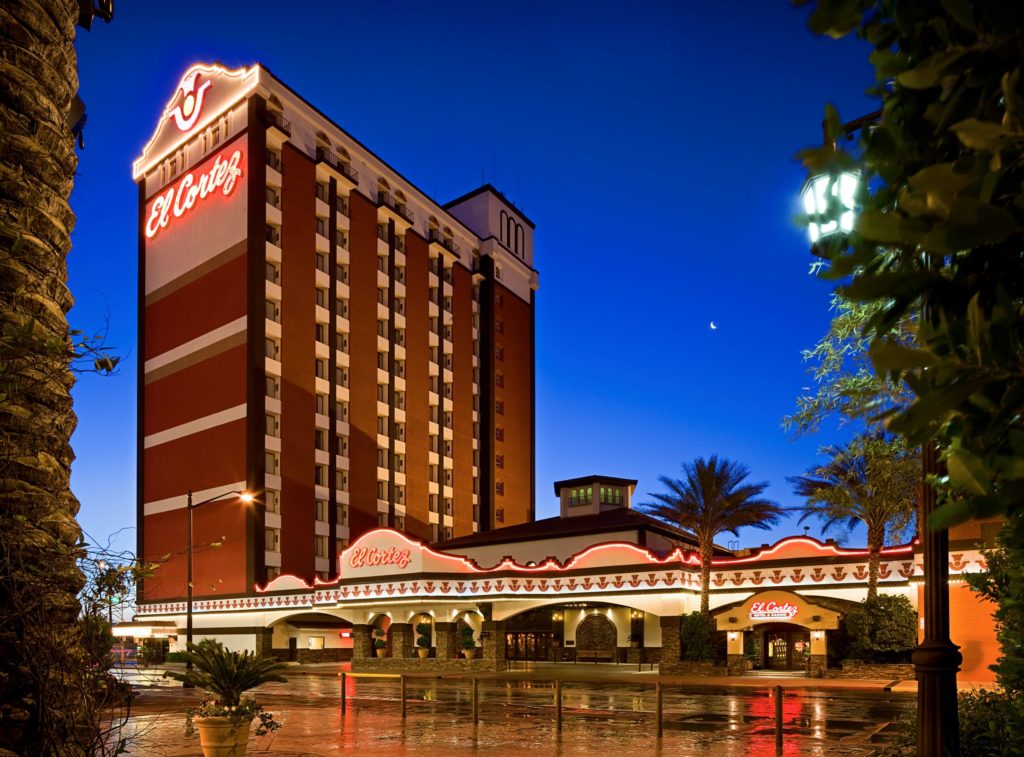
Today, the El Cortez lives on quite well, as a sort of time machine. Unlike nearly all other vintage Las Vegas resorts, it looks a lot as it did originally, following an exterior renovation in the early 1950s and numerous interior redecorations over more than 70 years. With a new hotel tower in 1980 and other improvements, the place now boasts of 364 guest rooms, luxury suites and modern amenities like a fitness center and in-room wi-fi.
In 2013, the National Park Service added the El Cortez to the National Registry of Historical Places. The Park Service observed that the hotel stands as an example of “Spanish Colonial Revival” architecture. Just the way Grayson and Hicks intended.
Feedback or questions? Email blog@themobmuseum.org





